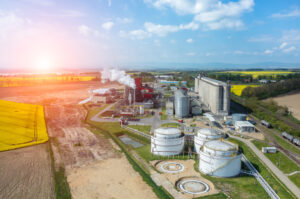 In honor of Earth Month, we’re shining a weekly spotlight on our industry partners dedicated to preserving the planet. This week we’re applauding ethanol production plants, for their positive impact on renewable energy in America.
In honor of Earth Month, we’re shining a weekly spotlight on our industry partners dedicated to preserving the planet. This week we’re applauding ethanol production plants, for their positive impact on renewable energy in America.
Ethanol production didn’t always have a stellar reputation because it exhausted more energy to produce it than the process could yield. Thanks to technological advancements, ethanol is now one of the primary renewable energy sources in our country today.
With nearly 200 operating plants across the U.S., ethanol is used in the beverage, cosmetic, and chemical industries, among others. These plants are modern marvels, turning harvested corn from the nation’s agricultural heartland in the Midwest and Great Plains into a variety of products. Nothing is wasted. Depending on the plant, byproducts of ethanol production include starch, oil, corn flour, bran, high-protein animal feed, and more.
Fuel Sustainability
The U.S. is a primary player in the ethanol market, both in production and consumption—most popular being for transportation fuel. Gasoline blended with ethanol reduces air pollution, cuts down on greenhouse gas emissions, and provides an important sustainability element to the nation’s fuel use profile.
Full-Circle Compliance
Like most large industrial facilities, the ethanol production process generates some air and water pollutants, as well as solid waste. The EPA and local agencies hold ethanol plants to strict standards designed to protect human health and our shared environment.
Alliance Technical Group is proud to partner with the ethanol industry and help ensure those standards are met with our source sampling, laboratory, ambient air monitoring, continuous emissions monitoring, and engineering services.
FUN FACT:
In the old west, bartenders often watered-down whiskey and charged full price. Cowboys discovered a test: mixing whiskey with gunpowder and igniting it proved its authenticity if it contained at least 50% ethanol. This gave rise to the term “proof”— if it burned, it was genuine. Over time, “100 proof” became synonymous with 50% alcohol by volume, with 40% being 80 proof, and 75% being 150 proof.